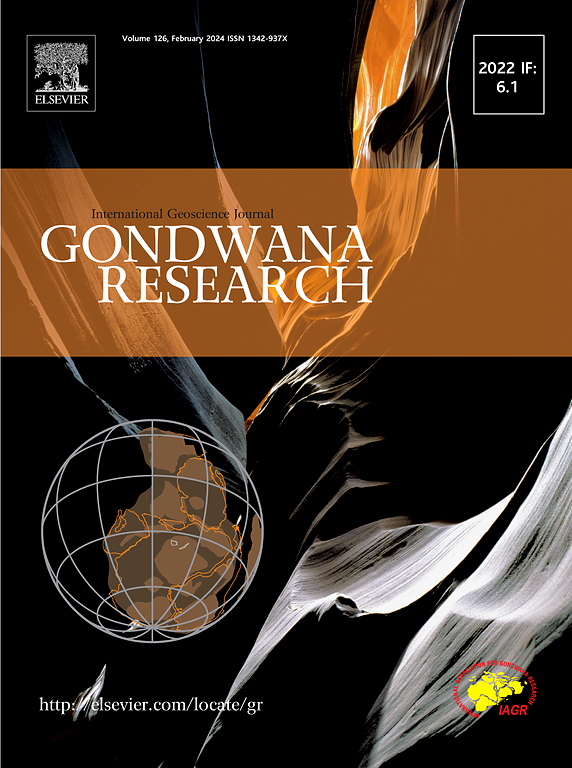Adsorption of methyl parathion on four various microplastics in aqueous solution: Kinetics, isotherms and molecular dynamics simulations
IF 7.2
1区 地球科学
Q1 GEOSCIENCES, MULTIDISCIPLINARY
引用次数: 0
Abstract
Microplastics (MPs) not only have biotoxicity but also affect the migration and bioavailability of many pollutants as their carriers, which pose potential ecological threats. This work mainly focused on the adsorption kinetics, adsorption isotherms, influencing factors (pH, temperature, salinity, particle size, and humic acid), and desorption (in four simulated environments) of an organophosphorus pesticide methyl parathion on four dominant MPs. In addition, MD simulations were used to analyze the adsorption progress of methyl parathion on MPs at a molecular level. The results showed that the methyl parathion reached equilibrium within 48h and the absorption capacity of various MPs for methyl parathion was as follows: polypropylene (0.8357 mg/g) > polyvinyl chloride (0.4285 mg/g) > polystyrene (0.2681 mg/g) > polyethylene (0.2119 mg/g). The adsorption data were described well by the pseudo-second-order kinetics model and Redlich-Petersen isotherms model, respectively, indicating a combination of monolayer and multilayer adsorption. The methyl parathion sorption onto MPs decreased with pH, due to the interaction between MPs and methyl parathion by effecting the surface charge effects of them. The adsorption capacity of methyl parathion on various MPs was also inversely proportional to other environmental factors such as temperature, salinity, and humic acid (HA). Moreover, smaller particle size was beneficial for the adsorption of MPs due to its large specific surface area. The desorption results showed Methyl parathion would desorb from the loaded MPs in all simulated environments such as intestinal juice, simulated intestinal fluid, artificial seawater, and artificial fresh water. Notably, the desorption was most pronounced in artificial freshwater, especially by PP with a desorption rate of 52.48 %. The results of the MD simulation effectively exhibited the adsorption process and characteristics of MPs at different temperatures, particle sizes, and types of MPs. Combine MD simulation, FTIR spectra, and the enthalpy analysis, indicated the adsorption processes occur on the surface of MPs and physical adsorption was the main mechanism. The results of this study may facilitate a better understanding of the MPs as sources and carriers for organic contaminants in various environments.

甲基对硫磷在四种不同微塑料水溶液中的吸附:动力学、等温线和分子动力学模拟
微塑料不仅具有生物毒性,还会影响许多污染物作为载体的迁移和生物利用度,对生态环境构成潜在威胁。本文主要研究了有机磷农药甲基对硫磷在4种优势MPs上的吸附动力学、吸附等温线、影响因素(pH、温度、盐度、粒径、腐植酸)和解吸(在4种模拟环境下)。此外,采用分子动力学模拟方法从分子水平上分析了甲基对硫磷在MPs上的吸附过程。结果表明:甲基对硫磷在48h内达到平衡,各MPs对甲基对硫磷的吸附量为:聚丙烯(0.8357 mg/g) >;聚氯乙烯(0.4285 mg/g);聚苯乙烯(0.2681 mg/g);聚乙烯(0.2119 mg/g)。拟二级动力学模型和Redlich-Petersen等温线模型均能很好地描述吸附数据,表明吸附是单层和多层相结合的。甲基对硫磷在MPs上的吸附随pH值的增加而减少,这是由于MPs与甲基对硫磷的相互作用影响了它们的表面电荷效应。甲基对硫磷对各种MPs的吸附量也与其他环境因子如温度、盐度和腐植酸(HA)成反比。此外,较小的粒径具有较大的比表面积,有利于MPs的吸附。解吸结果表明,在肠液、模拟肠液、人工海水和人工淡水等模拟环境中,甲基对硫磷都能从负载的MPs中解吸。在人工淡水中解吸效果最明显,其中PP解吸效果最好,解吸率为52.48%。MD模拟的结果有效地展示了不同温度、不同粒径和不同类型MPs的吸附过程和特性。结合MD模拟、FTIR光谱和焓值分析表明,吸附过程发生在MPs表面,物理吸附是主要机理。本研究的结果可能有助于更好地理解MPs作为各种环境中有机污染物的来源和载体。
本文章由计算机程序翻译,如有差异,请以英文原文为准。
求助全文
约1分钟内获得全文
求助全文
来源期刊

Gondwana Research
地学-地球科学综合
CiteScore
12.90
自引率
6.60%
发文量
298
审稿时长
65 days
期刊介绍:
Gondwana Research (GR) is an International Journal aimed to promote high quality research publications on all topics related to solid Earth, particularly with reference to the origin and evolution of continents, continental assemblies and their resources. GR is an "all earth science" journal with no restrictions on geological time, terrane or theme and covers a wide spectrum of topics in geosciences such as geology, geomorphology, palaeontology, structure, petrology, geochemistry, stable isotopes, geochronology, economic geology, exploration geology, engineering geology, geophysics, and environmental geology among other themes, and provides an appropriate forum to integrate studies from different disciplines and different terrains. In addition to regular articles and thematic issues, the journal invites high profile state-of-the-art reviews on thrust area topics for its column, ''GR FOCUS''. Focus articles include short biographies and photographs of the authors. Short articles (within ten printed pages) for rapid publication reporting important discoveries or innovative models of global interest will be considered under the category ''GR LETTERS''.
 求助内容:
求助内容: 应助结果提醒方式:
应助结果提醒方式:


